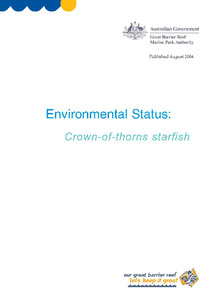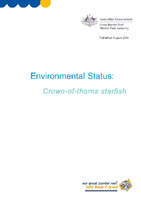Please use this identifier to cite or link to this item:
https://hdl.handle.net/11017/672

| Title: | State of the Reef Report 2004: Crown-of-thorns starfish |
| Authors: | Hoey, J. Chin, A. Great Barrier Reef Marine Park Authority |
| metadata.dc.subject.asfa: | Ecosystem disturbance Predator control |
| APAIS Subject: | Environmental impact Ecology |
| metadata.dc.subject.location: | Reef-wide |
| metadata.dc.subject.category: | Animals Incidents Weeds, pests and disease |
| Year of publication: | 2004 |
| Publisher: | Great Barrier Reef Marine Park Authority |
| Series/Report no.: | State of the Reef Report |
| Abstract: | The crown-of-thorns starfish is one of only a few animals that feed on living coral tissue. The starfish is named for the dense covering of long, sharp spines on its upper surface. At low densities the crown-of-thorns starfish is a ‘normal’ part of the reef’s ecology. However, when the numbers of crown-of-thorns starfish on a reef increase to the point where they consume coral faster than it can grow, the starfish can dramatically reduce coral cover, resulting in a major disturbance to the whole system (see Environmental status - corals). This situation is commonly known as a crown-of-thorns starfish ‘outbreak’. Outbreaks of crown-of-thorns starfish have been a concern on the Great Barrier Reef for more than 40 years. Research suggests that the outbreak ‘trigger point’ is around 30 mature crown-of-thorns starfish per hectare of coral reef that has average levels of coral cover. Once crown-of-thorns starfish densities exceed this threshold, the population will begin to consume coral faster than it can grow and is considered to be an outbreak population. |
| URI: | https://hdl.handle.net/11017/672 |
| Type of document: | Report |
| Appears in Collections: | Effects |
Files in This Item:
| File | Description | Size | Format | |
|---|---|---|---|---|
| Hoey_etal_2004_Crown-of-thorns_starfish_The_state_of_the_GBR_on-line.pdf | Main document | 4.1 MB | Adobe PDF |  View/Open |
Items in ELibrary are protected by copyright, with all rights reserved, unless otherwise indicated.
